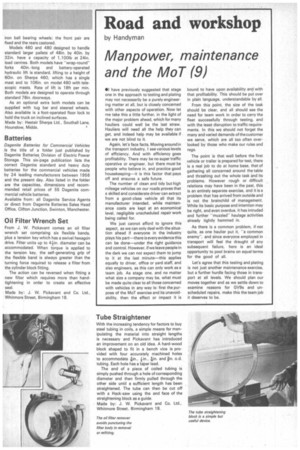Road and workshop
Page 117

If you've noticed an error in this article please click here to report it so we can fix it.
by Handyman
Manpower, maintenance and the MoT (9)
ffl have previously suggested that stage one in the approach to testing and plating may not necessarily be a purely engineering matter at all, but is closely concerned with other aspects of operation. Now let me take this a little further, in the light of the major problem ahead, which for many hauliers could well be the last straw. Hauliers will need all the help they can get, and indeed help may be available if we are not blind to it.
Again, let's face facts. Moving around in the transport industry. I see various levels of efficiency. And with efficiency goes profitability, There may be no super traffic operative or engineer, but there must be people who believe in, and practice good housekeeping—it is this factor that pays off and ensures a safe future.
The number of clean and tidy but high mileage vehicles on our roads proves that a skilled and considerate driver can extract from a good-class vehicle all that its manufacturer intended, while maintenance costs are kept at an economical level, negligible unscheduled repair work being called for.
We just cannot afford to ignore this aspect, as we can only deal with the situation ahead if everyone in the industry plays his part—there is every evidence this can be done—under the right guidance and control. However, if we leave people in the dark we can not expect them to jump to it at the last minute—this applies equally to driver, office or yard staff, and also engineers, as this can only work as a team job. As stage one, and no matter what size a company may be, what must be made quite clear to all those concerned with vehicles in any way is: first the purpose of the MoT exercise and its unavoidability, then the effect or impact it is bound to have upon availability and with that profitability. This should be put over in plain language, understandable by all.
From this point, the size of the task should be clear, and all should see the need for team work in order to carry the fleet successfully through testing, and with the least disruption to traffic requirements. In this we should not forget the many and varied demands of the customer we serve, which are all too often overlooked by those who make our rules and regs.
The point is that well before the first vehicle or trailer is prepared for test, there is a real job to do at home base, that of gathering all concerned around the table and thrashing out the whole task and its problems. However rough or difficult relations may have been in the past, this is an entirely separate exercise, and it is a problem that has arrived from outside and is not the brainchild of management. While its basic purpose and intention may be right, and even overdue, it has intruded and further "muzzledhaulage activities already tightly hemmed in.
As there is a common problem, if not quite, as one haulier put it, "a common enemy-, and since everyone employed in transport will feel the draught of any subsequent failure, here is an ideal opportunity to pool brains on equal terms for the good of all.
Let's agree that this testing and plating is not just another maintenance exercise, but a further hurdle facing those in transport at all levels. We should plan our moves together and as we settle down to examine reasons for GV9s and unscheduled repairs, make this the team job it deserves to be.




































































































































































































































































